Normally in our performance feature we focus on the engine – after all, this is what makes your car go faster, but it is not the end of the performance story.
A drag racer has an amazingly powerful engine, top cars can cover the 1,000-foot NHRA course in as little as 3.6 seconds reaching a top speed of over 335 mph but would be of little use driving from Auckland to the ski fields in the shortest legal time.
True performance for a road car is a synergistic mix of engine power and torque, transmission performance suspension and steering ability, tyre grip, braking ability and even driver comfort. At night lighting performance can be added. If any of these are not optimum, then you won’t get the best performance in a holistic sense.
Engine performance for everyday driving is more about the flexibility of torque delivery rather than outright power – a very peaky engine with a narrow torque band will be fast when driven in the optimum way but most drivers would not achieve this for major parts of a longer trip – and would tire quickly. Rather a vehicle with good power and a wide torque curve will be quicker overall and more pleasant to drive. This is where turbo and super-charged vehicles can excel (And EVs).
Transmission performance is again around getting a seamless feel – most modern automatics deliver this out of the box with their multiple speeds. Performance increases in this area might be more around catering for heavy use such as towing with enhanced cooling.
Suspension performance is a bit like engine performance – a race suspension set up might be fastest on smooth roads like a racetrack but will be challenged on more real-world roads that tend be less even, not to mention that the driver will be exhausted by all the bouncing around on a longer trip. A system that provides great grip with good compliance will usually be the top performer.
Great brake performance is not only important to allow good performance it is also a significant aid in giving the driver confidence in the vehicle, letting them extract more of the performance potential from the vehicle.
It might seem strange including comfort – and to be fair, over a short 10km sprint along a windy road, it is probably not of top concern, but over a 100 or 200km road trip being comfortable will decrease the overall trip time as it helps the driver keep concentration and maintain a good average pace. As distances increase the importance grows. Comfort can encompass noise levels, the support and comfort of the seating and even the climate control and audio system.
So next time a client wants to improve their vehicle’s performance. make sure you help them look at the full range of options to extract the potential.






